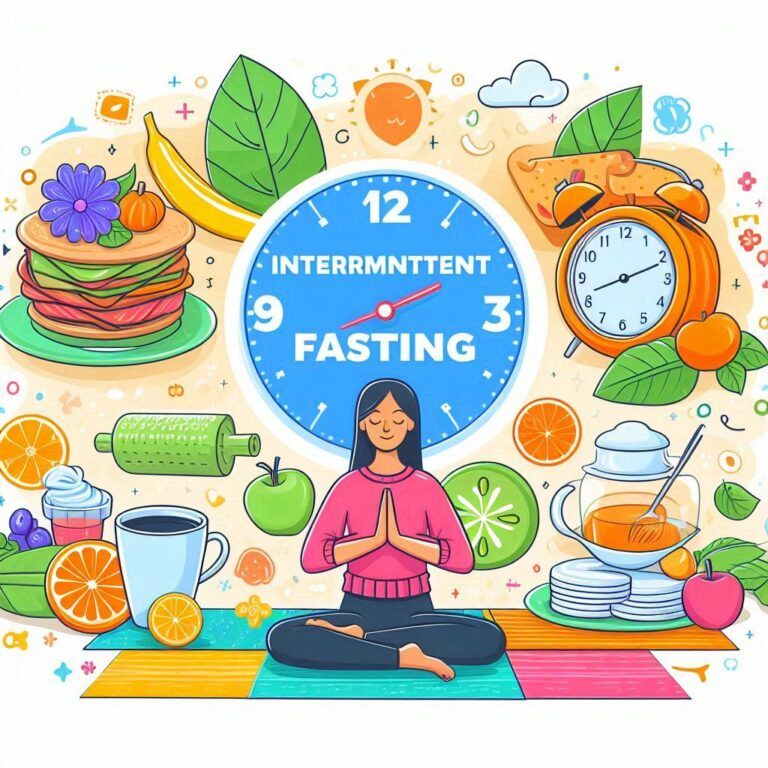Intermittent Fasting And Metabolism
Today, I’ll discuss intermittent fasting and its impact on metabolism. You’re not alone if you’re curious about intermittent fasting (IF).
Through my conversations with nutrition experts and health enthusiasts, it’s clear that intermittent fasting has gained significant attention for weight management and health improvement. Before diving into its metabolic effects, let’s clarify intermittent fasting.
Intermittent fasting is a dietary lifestyle that alternates between periods of fasting and eating. You’ll learn about various formats, such as the 16/8 method—fasting for 16 hours followed by an 8-hour eating window—or the 5:2 approach, which involves eating normally for 5 days and limiting calorie intake for the remaining 2 days each week.
Your metabolism — consists of enzymes and hormones that convert food into energy and regulate how efficiently your body uses that energy. It’s natural to wonder how shifting eating patterns with Intermittent Fasting could impact this intricate system. Does it rev up your metabolic engine or coast it into a relaxed, less active state?
Evidence suggests that Intermittent Fasting can recalibrate our metabolic health. It’s not just about potentially speeding up the metabolism; it also affects how our bodies manage blood sugar and store fat. The cited benefits range from improved fat burning and reduced insulin resistance to better cell stress resistance.
Your first step into Intermittent Fasting can be manageable. You’ll walk away with a clearer understanding of how it may harmonize with your body’s rhythms. In the next section, let’s explore the biological mechanisms behind intermittent fasting.

The Biological Mechanisms Behind Intermittent Fasting
I will walk you through the fascinating inner workings of your body when you fast. Think of your metabolism as a complex engine that can adjust its fuel usage based on what’s available. Intermittent fasting tweaks this engine in some unique ways.
Let’s start with the fasting phases. Your body goes from a fed state right after a meal to a post-absorptive state and then finally into a fasted state. In the fasted state, your hormone levels adjust to signal that it’s time to use stored energy.
During intermittent fasting, you’re essentially flipping a metabolic switch. This switch gears your body away from glucose, which would typically come from your meals, towards the breakdown of fat to Ketone for energy. This process, known as ketosis, kicks in when your glucose reserves run low, leading to potential benefits like weight loss and improved metabolic markers.
Let’s talk about insulin, the hormone that regulates blood sugar. Fasting helps improve your body’s response to insulin, potentially lowering your risk for type 2 diabetes. Each fasting cycle is like a reset button, clearing out glucose and nudging your body to become more sensitive to insulin.
You might wonder about your Resting Energy Expenditure (REE), also known as Resting Metabolic Rate (RMR), or how many calories you burn at rest. Research suggests that intermittent fasting (IF) can increase the energy you burn while resting, making it a possible ally in your weight management efforts.
The science backs up these benefits, with numerous studies highlighting how intermittent fasting can improve metabolic health. But remember, it’s not a one-size-fits-all scenario. Adjustments and considerations are crucial to tapping into these advantages safely and effectively.
Now, you could feel eager to give intermittent fasting a shot, or maybe you’ve already started. Either way, you should ensure you’re going about it in the smartest way possible. In the next section, I’ll hand over some handy tips for making your intermittent fasting journey as smooth as possible. From finding your ideal fasting window to balancing exercise and managing hunger, we will cover it all so you can fast-track your way to better metabolic health.

Practical Tips and Considerations for Efficient Intermittent Fasting
Adapting the process to your lifestyle and needs is crucial to getting the most out of your intermittent fasting journey. Don’t worry too much about sticking rigidly to a schedule that doesn’t feel right; you can constantly adjust your approach to your lifestyle. I like to start fasting half an hour before bed and fast for 8 hours while I sleep. After I wake up, I don’t eat until noon or later, maybe one.
Managing hunger is a central part of fasting, and it’s essential to focus on nutritious and filling foods during your eating windows. To satisfy you, choose something that resonates with you, like high-fiber vegetables, lean proteins, and healthy fats.
Staying hydrated is critical. Water isn’t just a thirst-quencher. It’s also crucial for maintaining metabolic processes. Always make sure you’re drinking enough, especially if you’re fasting during the warmer months or when you’re more active.
Speaking of activity, listen to your body if you pair exercise with intermittent fasting. Some people feel best working out on an empty stomach, while others may need a light snack to maximize their workout.
Finally, always remember your first attempt at intermittent fasting doesn’t need to be your last. It’s a learning process. Seek guidance from nutrition professionals, especially if you have health concerns, and ensure your fasting plan aligns with your medical needs and health goals.
FAQ Section: Intermittent Fasting and Metabolism
Intermittent fasting (IF) has gained popularity among those seeking to manage their weight and enhance their health. Many questions surround its effects on metabolism, so addressing some of the most common inquiries is essential.
Here, I answer frequently asked questions about intermittent fasting and its impact on your body.
1. What happens to your body after 1 month of intermittent fasting?
After one month of intermittent fasting, many people experience noticeable body and overall health changes. Typically, you might see weight loss due to reduced calorie intake and improved metabolic efficiency. Additionally, you may experience enhanced insulin sensitivity, leading to better blood sugar control. As the body adapts to a new eating pattern and becomes more efficient, some individuals notice increased energy levels and improved mental clarity.
2. What is the best intermittent fasting (IF) window to lose belly fat?
The best intermittent fasting window to lose belly fat varies from person to person, but the 16/8 method is widely recommended. This is fasting for 16 hours and eating during an 8-hour window. It helps promote weight loss and reduce overall calorie intake, including belly fat. Consistency and a balanced diet during the eating window are crucial for achieving the best results. You may want to consult with your healthcare professional.
3. Do you poop a lot during intermittent fasting?
Intermittent fasting can affect bowel movements, but it doesn’t necessarily mean you will poop a lot. Some people might experience changes in their digestive system as their body adjusts to a new eating schedule. Initially, you might notice variations in the frequency and consistency of your stools. Staying hydrated and consuming a fiber-rich diet during your eating periods can help maintain regular bowel movements.
4. Why do I have weird poop while fasting?
Weird poop during fasting can result from several factors, including changes in diet, hydration levels, and digestive rhythms. During fasting, the lack of regular meals can change how often bowel movements occur and their consistency.
Consuming nutrient-dense, fiber-rich foods during eating periods, staying well-hydrated, and gradually adapting to the fasting routine can help alleviate unusual bowel movements. If digestive issues persist, consulting with a healthcare provider is advisable to ensure no underlying health concerns.
You should check out my other post on Calories In Vs. Calories Out The Key To Weight Loss.
Engage with Me!
Ask Questions: If you have any questions about Intermittent Fasting or Metabolism. Please leave them in the comments below. Thank You!







